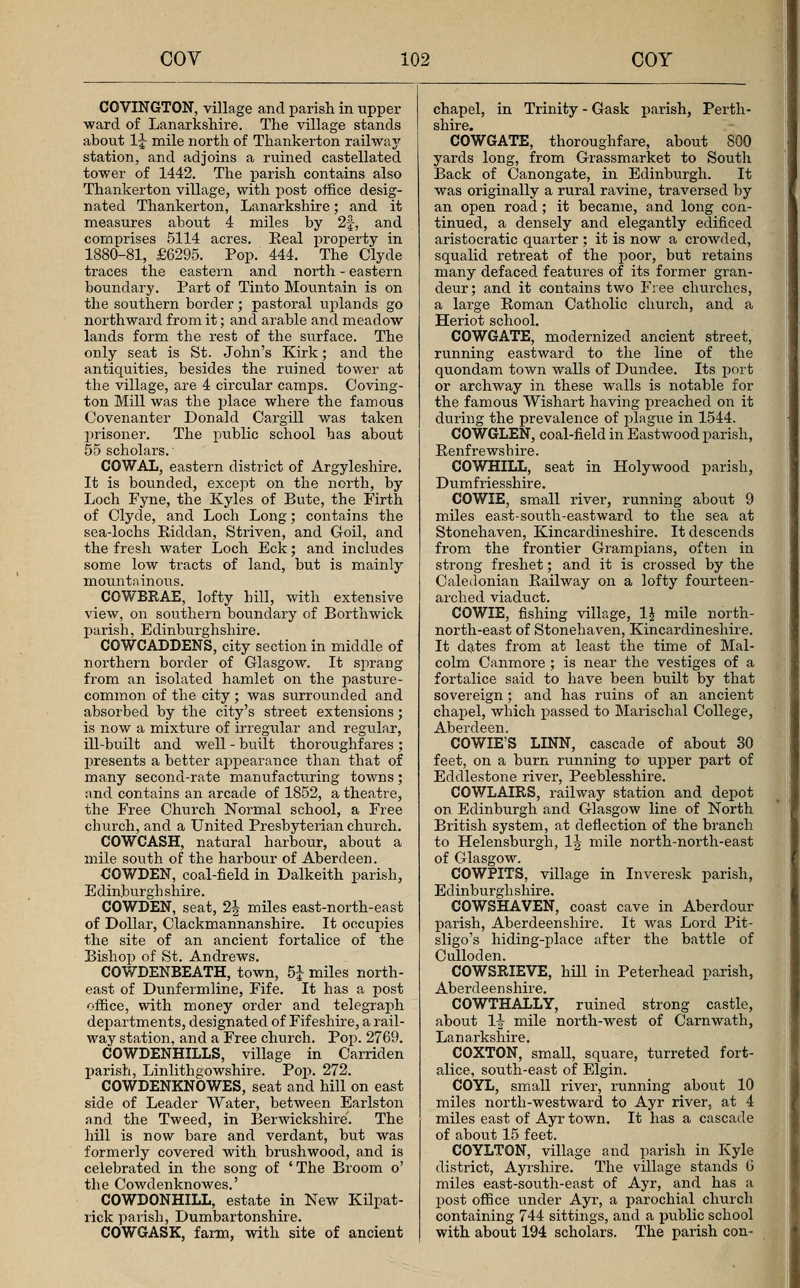COVINGTON, village and parish in tipper ward of Lanarkshire. The village stands about 1 mile north of Thankerton railway station, and adjoins a ruined castellated tower of 1442. The parish contains also Thankerton village, with post office designated Thankerton, Lanarkshire; and it measures about 4 miles by 2f, and comprises 5114 acres. Real property in 1880-81, 6295. Pop. 444. The Clyde traces the eastern and north-eastern boundary. Part of Tinto Mountain is on the southern border ; pastoral uplands go northward from it ; and arable and meadow lands form the rest of the surface. The only seat is St. John's Kirk; and the antiquities, besides the ruined tower at the village, are 4 circular camps. Covington Mill was the place where the famous Covenanter Donald Cargill was taken prisoner. The public school has about 55 scholars.
COWAL, eastern district of Argyleshire. It is bounded, except on the north, by Loch Fyne, the Kyles of Bute, the Firth of Clyde, and Loch Long ; contains the sea-lochs Riddan, Striven, and Goil, and the fresh water Loch Eck ; and includes some low tracts of land, but is mainly mountainous.
COWBRAE, lofty hill, with extensive view, on southern boundary of Borthwick parish, Edinburghshire.
COWCADDENS, city section in middle of northern border of Glasgow. It sprang from an isolated hamlet on the pasture-common of the city ; was surrounded and absorbed by the city's street extensions ; is now a mixture of irregular and regular, ill-built and well-built thoroughfares ; presents a better appearance than that of many second-rate manufacturing towns ; :ind contains an arcade of 1852, a theatre, the Free Church Normal school, a Free church, and a United Presbyterian church.
COWCASH, natural harbour, about a mile south of the harbour of Aberdeen.
COWDEN, coal-field in Dalkeith parish, Edinburghshire.
COWDEN, seat, 2 miles east-north-east of Dollar, Clackmannanshire. It occupies the site of an ancient fortalice of the Bishop of St. Andrews.
COWDENBEATH, town, 5J miles north-east of Dunfermline, Fife. It has a post office, with money order and telegraph departments, designated of Fifeshire, a rail-way station, and a Free church. Pop. 2769
COWDENHILLS, village in Carriden parish, Linlithgowshire. Pop. 272.
COWDENKNOWES, seat and hill on east side of Leader Water, between Earlston !in<l the Tweed, in Berwickshire. The hill is now bare and verdant, but was formerly covered with brushwood, and is celebrated in the song of 'The Broom o' the Cowdenknowes.'
COWDONHILL, estate in New Kilpatrick parish, Dumbartonshire.
COWGASK, farm, with site of ancient chapel, in Trinity-Gask parish, Perthshire.
COWGATE, thoroughfare, about 800 yards long, from Grassmarket to South Back of Canongate, in Edinburgh. It was originally a rural ravine, traversed by an open road ; it became, and long continued, a densely and elegantly edificed aristocratic quarter ; it is now a crowded, squalid retreat of the poor, but retains many defaced features of its former grandeur; and it contains two Free churches, a large Roman Catholic church, and a Heriot school.
COWGATE, modernized ancient street, running eastward to the line of the quondam town walls of Dundee. Its port or archway in these walls is notable for the famous Wishart having preached on it during the prevalence of plague in 1544.
COWGLEN, coal-field in Eastwood parish, Renfrewshire.
COWHILL, seat in Holywood parish, Dumfriesshire.
COWIE, small river, running about 9 miles east-south-east ward to the sea at Stonehaven, Kincardineshire. It descends from the frontier Grampians, often in strong freshet ; and it is crossed by the Caledonian Railway on a lofty fourteen-arched viaduct.
COWIE, fishing village, 1 mile north-north-east of Stonehaven, Kincardineshire. It dates from at least the time of Malcolm Canmore ; is near the vestiges of a fortalice said to have been built by that sovereign ; and has ruins of an ancient chapel, which passed to Marischal College, Aberdeen.
COWIE'S LINN, cascade of about 30 feet, on a burn running to upper part of Eddlestone river, Peeblesshire.
COWLAIRS, railway station and depot on Edinburgh and Glasgow line of North British system, at deflection of the branch to Helensburgh, 1J mile north-north-east of Glasgow.
COWPITS, village in Inveresk parish, Edinburghshire.
COWSHAVEN, coast cave in Aberdour parish, Aberdeenshire. It was Lord Pitsligo's hiding-place after the battle of Culloden.
COWSRIEVE, hill in Peterhead parish, Aberdeenshire.
COWTHALLY, ruined strong castle, about 1 mile north-west of Carnwath, Lanarkshire.
COXTON, small, square, turreted fort-alice, south-east of Elgin.
COYL, small river, running about 10 miles north-westward to Ayr river, at 4 miles east of Ayr town. It has a cascade of about 15 feet.
COYLTON, village and parish in Kyle district, Ayrshire. The village stands G miles east-south-east of Ayr, and has a post office under Ayr, a parochial church containing 744 sittings, and a public school with about 194 scholars. The parish contains also the villages of Craigliall, Bankfoot, Gadgirthholm, Knockshoggleholm, and Joppa. Its length is about 12 miles ; its breadth nearly 2 miles ; its area 11,584 acres. Real property in 1880-81, 20,947. Pop. 3100. The river Ayr traces much of the north-western boundary ; the Coyl traverses the interior ; and the Doon drains part of the south-eastern end. The lower section is partly flat and partly undulating ; the middle section contains the Craigs of Coyl, rising to a height of 798 feet above sea-level ; and the upper section is hilly, rises to a height of more than 1100 feet above sea-level, and commands there extensive views. About 8110 acres are arable. Coal, limestone, sandstone, and trap rock abound, and are extensively worked. The chief seats are Sundrum, Gadgirth, and Rankinston; and a chief antiquity is a large stone popularly re-girded as a monument of 'Auld King oil,' a fabulous monarch from whom a false tradition derived the names of Coyl, Coylton, and Kyle.

